Uncertainty pervades the economy these days and the construction industry reflects that with unemployment lower, varying strength among sectors and constant concern about the rate of interest rate increases and the soundness of the banking system.
Associated Builders and Contractors reported that its Construction Backlog Indicator increased to 8.9 months in April from 8.7 in March. March saw a seven-month low. The April reading reading is 0.1 months higher than in April 2022. Nonetheless, backlog expanded in April, as infrastructure contractors began to take on more public works projects.
The backlog rebounded in April. ABC Chief Economist Anirban Basu said this was due to infrastructure contractors taking on more public works projects. Regionally, backlog increased in the Northeast and West but fell in the South and middle states.
“With credit conditions tightening, expectations are that private construction is poised for weaker times ahead,” Basu said.
There’s evidence to support those expectations. According to the AIA/Deltek Architecture Billings Index (ABI), business conditions softened at architecture firms in April. An index score below indicates a decline in firm billings. Billings at architecture firms have declined every month since last October, with the exception of a slight bump in March.
The AIA reports that while inquiries into new work continued to grow in April, the pace of growth remained relatively slow, and the value of new signed design contracts was essentially flat for the month. Billings at firms specializing in multifamily residential projects reached their lowest level since the height of the pandemic in 2020. These are some of the biggest customers for HVAC services.
Despite these signs on weakness, ABC’s Construction Confidence Index reading for sales and staffing moved higher in April, while the readings for profit margins inched lower. All three readings remain above the threshold of 50, indicating expectations of growth over the next six months.
Contractors are hiring as if they expect more work, as well. Construction employment increased year-over-year in 42 states in April, according to analysis by the Associated General Contractors of America. On a month-over-month basis, only 24 states added jobs. However, Ken Simonson, the association’s chief economist, said that was likely due to the impact of low unemployment rates and workforce shortages as opposed to a drop off in recent amounts of construction activity.
"Contractors continue to report strong demand for projects and have added employees in all but a handful of states over the past year," Simonson said. "The fact that employment dipped in April in half the states may reflect an inability to find qualified workers at a time of record-low construction unemployment, not a slowdown in demand."
The AAGC construction firms continue to pay premium wages that are above the national average for the overall economy to attract workers. Contractors are also still paying more materials and services used in nonresidential construction. Pirces rose 0.5 percent month-over-month in April, the largest increase since January. AAGC officials said latest new data indicates contractors are getting squeezed by rising materials prices at a time when what they charge to build projects is declining.
“Prices remain volatile for many key construction materials, making it difficult for contractors to bid projects that may take years to complete,” said Ken Simonson, the association’s chief economist. “Even some materials that have dropped in price recently have still posted year-over-year increases exceeding 10 percent.”
Patterns for key construction inputs varied widely in April. For example, the price of liquid asphalt increase 15.3 percent, while the price of asphalt paving mixtures and blocks decreased 5.9 percent.
Some uncertainty is starting to clear. A deal has been reached on the federal debt ceiling, for example. But many factors remain in play and could affect the construction industry, especially the HVAC segment, going forward.










